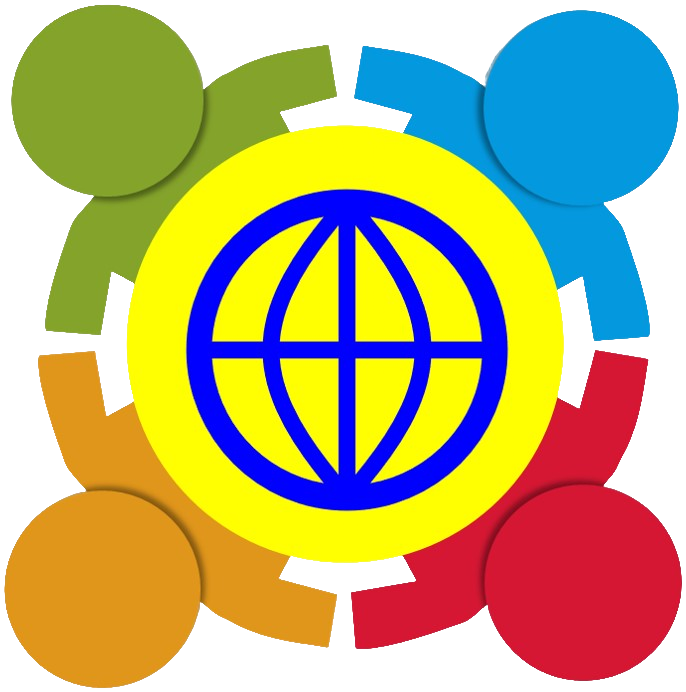對應國際教育議題實質內涵
彰顯國家價值
善盡全球公民責任
單元名稱 3
融入領域
語文、社會
上課節數:4節
年級:八年級
國際教育議題實質內涵
學生學習目標
總結性評量
Girl with A Powerful Voice(4節)
|
單元(一)單元名稱:(Girl with A Powerful Voice)
|
|||
| 教學節次 |
第(1)節~第(4)節
|
||
| 國際教育議題實質內涵 |
國J2 發展國際視野的國家意識
國J3 展現認同我國國家價值的行動
|
||
| 相關領域學習表現 (第二學習階段以上應包含英語文領域領綱) |
[領域一]
英語文領域: 1-Ⅳ-3 能聽懂基本或重要句型的句子。 2-Ⅳ-4 能以簡易的英語描述自己、家人及朋友 3-Ⅳ-9 能了解故事的主要內容與情節。 4-Ⅳ-5 能依提示寫出正確達意的簡單句子。 8-Ⅳ-5 能具有基本的世界觀。 [領域二] 社會領域: 公 1a-Ⅳ-1 與文化議題間的相互 關係。 理解公民知識的核心 概念 公 1b-Ⅳ-1比較社會現象的多種解釋觀點。 公 1c-Ⅳ-1 運用公民知識,提出 自己對公共議題的見 解。 社 3c-Ⅳ-1聆聽他人意見,表達 自我觀點,並能以同 理心與他人討論。 社 3d-Ⅳ-1規劃與執行社會領域 的問題探究、訪查、創 作或展演等活動。 |
||
|
校訂國際教育
雙語學習內容
|
領域學習內容 Content
|
||
|
1. 性別及教育平等之概念
2. 認識倡議性別及教育平等之國際女性 3. 比較我國性別及教育平等現況 4. 珍賞我國性別及教育之平等 5. 關心社會及世界,善盡全球公民責任。 |
|||
|
語言學習內容 Language of Learning
|
|||
|
目標字詞 target words:
Educational equity, non-equity 目標句型 target sentences: 第二節 1. We think Malala is _____, _____, and _____,because _____. 2. Malala is a woman who/with _____, and we think she is _____, because _____. 3. _____ can go to school. 4. _____ have educational equity. |
|||
|
單元學習目標
(50~100字內) |
透過英文導讀覺察國際間教育平權的倡議活動,進而透過數據觀察與歸納2國男女受教權現況,用雙語表達我國與巴基斯坦間的教育平權差異。
|
||
| 教學步驟 | 引導作法 | 教學資源 | 認知能力 |
|
~~~~~~~~第一節~~~~~~~~
一、暖身活動
1.開場白--教師以英文提問,中文補充:
Teacher may ask: Do you have any teenage idol or anyone at your age that you admire most? Why do you like this idol or person so much? What does he/she do that makes you admire him/her? Student may answer: Yes, Atom Boyz. 2.教師介紹全球最年輕之諾貝爾和平獎得主(暫不透漏其性別及姓名),正是一位青年人,在其青少年時期,因對其所關注之議題對世界之貢獻而獲獎。 3.教師利用 PPT 播映 Malala 經典名句: “One child, one book, and one pen can change the world!”,請學生朗讀並說出其中文意義。PPT 同時呈現三位人士之頭像,令學生猜猜是哪位人士所說的。 Teacher may say: Do you know about her? Is there anything special about her? What do you think of this saying? (學生可以中、英文回答,學生若以中文回答,教師以英文再說一次,並可對學生說: Is that what you mean?) 二、教師播放英文影片 Top Five Amazing Facts about Malala,輔以中文字幕。影片播畢,教師以英文提問,學生可選擇以英文或中文回答:
Teacher may say: Where is Malala from? What did Malala fight for in her teenage? What happened to her one day on her way to school, and it shocked the world? Did Malala stop her fighting after the gunshot? What achievement did Malala make? What prize did she get?(教師輔以中文解釋 achievement 之意義並寫在黑板上使大家學習) ~~~~~~~~第一節課結束~~~~~~~~~~ ~~~~~~~~~第二節課~~~~~~~~~
一、教師導讀 A Girl with a Powerful Voice—Malala 文章內容,輔以單字賓果遊戲。
1. 讀完文章後,學生歸納 Malala 生平於 Empathy Map 學習單。2. 學生分組討論,主題:
(1) What kind of person do you think Malala is? Please use at least 3 adjectives to describe her.
(2) What impresses you most? What do you think you can learn from her? 3. 各組分享討論內容,其中至少包含 3 個對 Malala 之形容詞,並且使用下列句型之一:
(1) We think Malala is ________, ________, and ________,because ___________.
(2) Malala is a woman who/with _____, and we think she is_______, because ________. 4. 各組將上列句型寫入教師所發之海報紙,完成後貼於教室牆面。5. 學生進行 Gallery Walk,並使用立可貼,在立可貼上至少寫下一句話,作為回饋貼在各組之海報上。
~~~~~~~~~第二節課結束~~~~~~~~~
~~~~~~~~~第三節課~~~~~~~~~
一、請學生反思巴基斯坦「女性教育權」是否平等。
Teacher may say:
In Pakistan, can girl go to school? Student may say: No. 二、教師帶入 educational equity 的涵義。老師呈現 equity 及 non-equity 的圖片,請孩子觀察差別,理解 equity 的涵義。
Teacher may say:
Educational equity: Boys, girls, everyone can go to school. Educational Non-equity, someone can’t go to school. Teacher may say: In Taiwan, who can go to school? Students may say: Everyone. 三、與我國現況比較: 教育部提供的學校性別比例。
Teacher may say:
You can see the number of boys and the number of girls are almost the same, 50-50. How about Pakistan? 教師帶入巴基斯坦的數據,讓學生討論現在的巴基斯坦是否具備educational equity. 四、教師結論2國的教育平權差異。
Student may say:
In Taiwan, we have educational equity. In Pakistan, they don’t have educational equity./In Pakistan, 他們還沒有達到educational equity. ~~~~~~~~~第三節課結束~~~~~~~~~
~~~~~~~~~第四節課~~~~~~~~~ 一、教師將前一節課,學生所觀察到的巴基斯坦教育現況,引導學生回憶個人對Malala的印象,請學生以這些基礎,寫一封支持信給Malala。
Teacher may say:
Write a personal letter to Malala to encourage her and congratulate her on helping women all over the world fight for equality. Your letter should be about 2 to 3 paragraphs long. Introduce yourself and tell her what you think of her and her work. Try to use the sentences: 1. We think you (Malala) are ________, ________, and ________,because ___________. 2. You (Malala) are a woman who/with _____, and we think you are_______, because ________. 3. In Taiwan, we have educational equity. 4. We wish you have educational equity. 二、教師引導學生完成信件,並適時提醒目標句型的使用。
~~~~~~~~~第四節課結束~~~~~~~~~
|
Malala簡報單元1
Malala簡報單元1 Quotes of Malala Malala及其他倡議人權之女性圖片 影片Top Five Amazing Facts about Malala Malala文章 Malala簡報單元1 單元一學習單 Empathy Map 學習單 Malala簡報單元1 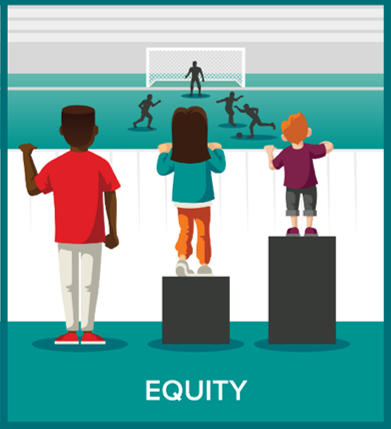 教育部性別統計指標 (https://depart.moe.edu.tw/ED 4500/cp.aspxn=DCD2BE18CF AF30D0) 「馬拉拉有改變巴基斯坦嗎?」報導 (https://www.cup.com.hk/2 018/07/20/female-education-in-pakistan/) 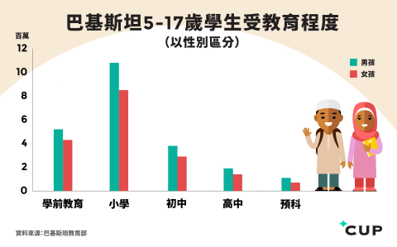 寫給馬拉拉的一封信範例 Sample of a letter to Malala A Letter to Malala |
能記憶Malala對教育平權的倡議事件。 理解A Girl with a Powerful Voice—Malala文章中Malala的行動與遭遇。 運用目標字詞句發表個人對Malala的評價。 理解教育平權與非平權的現象差異。 學生能覺察我國與巴基斯坦的教育現象差異,並判斷教育平權的程度。 學生能運用英語陳述對教育平權差異的觀察與判斷。 學生能運用雙語表達個人對教育平權的支持。 |
|
融入領域
上課節數:6節
年級:八年級
國際教育議題實質內涵
學生學習目標
總結性評量
Girl with A Powerful Voice-繪本設計(6節)
|
單元(二)單元名稱:(Girl with A Powerful Voice-繪本設計)
|
|||
| 教學節次 |
第( 5 )節~第(10)節
|
||
| 國際教育議題實質內涵 |
國 J2 發展國際視野的國家意識。
國 J3 展現認同我國國家價值的行動 |
||
| 相關領域學習表現 (第二學習階段以上應包含英語文領域領綱) |
[領域一]英語文
4-Ⅳ-2 能依圖畫、示書寫英文句子。 4-Ⅳ-5 能依提示寫出正確達意的簡單句子 [領域二]視覺藝術 視 1-Ⅳ-4 能透過議題創作,表達對生活環境及社會文化的理解。 |
||
|
校訂國際教育
雙語學習內容
|
領域學習內容 Content
|
||
|
我國與他國的教育平權差異。
將色彩運用在教育平權議題的技巧。 教育平權議題海報及共創繪本的內容構思方法 |
|||
|
語言學習內容 Language of Learning
|
|||
|
目標字詞 target words:
第一節及第二節 boys, girls, terrorists, educational equity 第三節及第四節 Feeling: anxious, angry, afraid, surprised, happy, sad. Color: red, orange, yellow, green, blue, purple. 目標句型 target sentences: 第一節及第二節 _____ can go to school. _____ don’t let _____ go to school 第三節及第四節 _____ have/doesn’t have educational equity. I feel _____ so I use _____ (color) in my picture book. |
|||
|
單元學習目標
(50~100字內) |
運用英語文共創馬拉拉語錄故事繪本及海報設計傳遞我國教育平權與他國的差異,表達個人對於國際教育平權主張之理解與認同。並對我國教育平權的價值延伸倡議教育平權的重要
|
||
| 教學步驟 | 引導作法 | 教學資源 | 認知能力 |
|
~~~~第五節~~~
一、教師複習單元一 Malala 國家所出現的上學情境,讓學生歸納及回憶我國與他國間,教育平權的差異。
Teacher may ask:
In Pakistan, who can go to school? Student may answer: Boys can go to school. Teacher may say: In Taiwan, who can go to school? Students may say: Boys can go to school. Girls can go to school, too. 教師複習 educational equity 的涵義。 老師呈現 equity 及 non-equity 的圖片,教師拿出第一單元2國的教育部數據幫助學生總結: Teacher may say: 請以小組方式,派一員代表,上台說 明觀察 educational equity 的結論。 Students may say: In Taiwan, we have educational equity. In Malala’s country, they don’t have educational equity. 二、教師請學生回憶Malala的故事,女學生不能 去上學的阻礙有哪些?
Teacher may say:
In Malala’s country Girls can’t go to school because … Students may say: Fathers don’t let girls go to school. Terrorists don’t let girls go to school. 三、教師總結並引導學生反思educational equity的重要性。
Teacher may say:
Malala期望能有educational equity,即使terrorists don’t let her go to school,請同學思考,為什麼educational equity對Malala這麼重要。 ~~~~~~~~第五節課結束~~~~~~~~~~
~~~~~~~~~第六節課~~~~~~~~~
一、教師引導學生閱讀 Malala 名句及 Malala 資訊圖表。 教師引導學生思考這些名句及圖表內容與 educational equity 的關聯。
Teacher may say:
Malala said: One child, one book, and on pen can change the world. Where do you see child, book, pen? 教師以選擇題方式提示學生,結合 7-11、 學校、餐廳,讓學生選擇。 當學生推理【學校】時,教師順勢引導學 學生回憶 Malala 倡議、行動的內容。 二、教師反問學生educational equity的重要性。 當學生提出接近【學習能提升個人能力】 的論述時,教師提出結論:
Teacher may say:
We go to school. We can 學習及提 升個人能力. (使用 translanguaging) After we 提升個 人能力, we can change the world. 教師引導學生反思為何 Malala 要追求 educational equity. 教師引導學生思考若教育平權落實,所帶 來的分工成就。 Teacher may say: Please think, if girl can’t go to school, only boys can change the world? Students may say: Yes. (部分學生可能提出 No 或猶豫) 三、教師引導學生思考運動比賽混雙的分工, 讓學生理解教育平權狀況,每個人能彼此 分工,才能完成各種工作,讓學生建立教 育平權與良好分工社會的關聯。 教師播放男女混雙比賽畫面,並說明彼此分工下取得勝利。
Teacher may say:
You see Taiwan team, the girl and the boy can play well. If girl don’t 提升個人能力, can they play well? Students may say: No, they don’t. Teacher may say: Great. In Malala’s country, girls can’t go to school. Can girls 提升個人能力? Students may say: No, girls can’t. Teacher may say: In Taiwan, boys and girls can go to school. Boys and girls can 提升個人能力 together. Boys and girls can work together. (本校學生有羽球隊打混雙,教師用撥放的混雙截圖,引導學生理解 work together) ~~~~~~~~~第六節課結束~~~~~~~~~
~~~~~~~~~第七節課~~~~~~~~~
一、教師帶入繪本製作及顏色運用技巧,並說明顏色所對觀賞者帶來的感受。老師使用顏色與感受,並舉出學生可能在呈現教育平權議題使用到的顏色與字彙。
二、教師帶入我國教育平權的情境,讓學生思考與色彩使用的連結。 Teacher may say:
In Taiwan, we have educational equity. Boys and girls can go to school. Boys and girls can 提升個人能力. You feel...(教師拉長語音並手指顏色 與感受圖的各種表情) Students may say: Happy. Teacher may say: Great. We see the educational equity. We feel happy, so we use _______(教師手指happy所對應之綠色,並等學生回答). Student may say: Green. Teacher may say: Great. We see the educational equity in Taiwan. We feel happy, so we use green. 三、教師播放Malala的故事,使用語言引導學生回憶該國教育不平權現況。
Teacher may say:
In Malala’s country, girls can’t go to school. They don’t have educational equity. Girls can’t 提升個人能力.You feel …(教師拉長語音並手指顏色與感受圖的各種表情). Student may say: Angry. (可能有其他感受,教師擇一項引導學生將感受完整表達) Teacher may say: Great. We don’t see the educational equity in Malala’s country. We feel angry, so we use ______(教師手指red所對應之紅色,並等學生回答). Student may say: Red. Teacher may say: Great. We don’t see the educational equity in Malala’s country. We feel angry, so we use red. 四、教師說明接下來會製作繪本,並請學生試著用目標句型表達個人對於Malala處境的感受,藉此練習對於Malala所處教育環境的感受,結合色彩、目標句型的表達:
Teacher may say:
About Malala doesn’t have educational equity, please write down how do you feel and what color will you use in your picture book. 五、學生為自己對於Malala沒有educational equity的處境,運用顏色、感受的句型寫下,教師請學生以口頭分享。
Student may say:
Malala doesn’t have educational equity. I feel angry, so I use red in my picturebook. 六、教師引導學生製作繪本,首先引導學生依據三部分構思繪本內容:
第一部分:We have educational equity in Taiwan.
第二部分:Malala doesn’t have educational equity in her country.
第三部分:Education equity is good/bad, because ________. I wish Malala have/doesn’t have education equity.
七、繪本第一部分製作
依據主軸We have educational equity in Taiwan,教師請學生造句,並提供範例給學生構思圖、文,請學生以圖文方式規劃與創作第一部分。 引導繪本文字撰寫:
Teacher may say: First, you write educational equity in Taiwan and what do you feel. Second, you draw a picture about Taiwan, school, boys and girls.(中文引導學生使用多種元素表達自己觀察到台灣教育平權的現象,不要侷限在範例圖) 八、教師帶色彩及感受的連結圖,引導學生為內容著色。
教師舉某位同學的內容,以此向大家說明,促使同學連結色彩與感受。
Teacher may say: ________(student’s name) feel happy. Look at colors and feeling (教師手指色彩及感受圖). You are happy, so you use _______ color (教師手指happy的顏色). 九、教師視情形舉更多實例並個別指導用色。
引導學生完成繪本的第一部分。
教師視情形引導學生用目標句型描述該部分的繪本內容,提升學生對議題的表達能力。
Student may say: We have educational equity. I feel happy. I use green in my pirure book. 複習 educational equity 的內涵,教師使 用前堂課的圖片,複習 educational equity 的意涵。 Teacher may say: In Pakistan, can girl go to school? Student may say: No. ~~~~~~~~~第七節課結束~~~~~~~~~
~~~~~~~~~第八節課~~~~~~~~~ 一、繪本第二部份製
依據主軸Malala doesn’t have educational equity in her country,教師請學生造句,並提供範例給學生構思圖、文,請學生以圖文方式規劃與創作第二部分。
引導繪本文字撰寫: Teacher may say: First, you write you see or don’t see educational equity in Malala’s country and what do you feel. Second, you draw a picture about Malala’s country, school, boys and girls.(中文引導學生使用多種元素表達自己觀察到Malala國家教育不平權的現象,不要侷限在範例圖) 二、教師帶色彩及感受的連結圖,引導學生為內容著色。
教師舉某位同學的內容,以此向大家說明,促使同學連結色彩與感受。
Teacher may say: ________(student’s name) feel sad. Look at colors and feeling (教師手指色彩及感受圖). You are sad, so you use _______ color (教師手指sad的顏色). 三、教師視情形舉更多實例並個別指導用色。
引導學生完成繪本的第二部分。
教師視情形引導學生用目標句型描述該部分的繪本內容,提升學生對議題的表達能力。 Student may say: Malala doesn’t have educational equity. I feel sad. I use blue in my pirure book. ~~~~~~~~~第八節課結束~~~~~~~~~
~~~~~~~~~第九節課~~~~~~~~~ 一、依據繪本第三部分主軸Education equity is good/bad, because ________. I wish Malala have/doesn’t have education equity.,教師引導學生反思第二節課提出的學習能「提升個人能力」及透過男生與女生「work together」能帶來好的發展。
教師引述先前學生的討論,說明上學能提升個人能力:
Teacher may say: We go to school, and we can 提升個人能力, right? Students may say: Yes. Teacher may say: Girls can go to school, so girls can 提升個人能力. Boys and girls can work together.(教師再次使用羽球隊混雙的畫面) Students may say: Yes. 二、教師確定學生對於educational equity已經有個人的價值判斷,教師開始請學生思考是否支持Malala的訴求。
Teacher may say:
Now please think “do you wish Malala have educational equity?”. 三、教師請學生自己先記錄下學生自己的意見。並開始引導學生以目標句型寫下:
Teacher may say:
First, if you think educational equity is good, please write “Educational equity is good” and write “why”, like “Educational equity is good, because boys and girls can work together”.(引導學生找出更多educational equity可能帶來的益處,適時讓學生用中文表達。同時請學生將該原因用圖片畫出,讓學生能完整使用語言、圖像表達個人價值判斷。) Teacher may say: Second, do you wish Malala have educational equity? Please write down, like “I wish Malala have educational equity.”. 四、教師引導學生運用目標句型,表達對於Malala訴求的支持或反對。 教師視情形引導學生用目標句型描述該部分的繪本內容,提升學生對議題的表達能力。
Student may say: Educational equity is good.I wish Malala have educational equity. ~~~~~第九節課結束~~~~
~~~~~第十節課~~~~
一、教師與學生共同辦理一場國際教育平權倡議會,請學生運用自製繪本向同學說明自己所觀察到的我國與他國的教育平權差異、對於教育平權的價值判斷、以及個人對於Malala訴求的個人支持與反對。
在發表時請學生使用目標句型:
Students may say: In Taiwan, boys and girls can go to school. I see educational equity in Taiwan. I feel happy. But Malala doesn't have educational equity. I feel sad. Educational equity is good. Boys and girls can work together. I wish Malala have educational equity. ~~~~第十節課結束~~~~
|
Malala簡報單元1
Malala 的故事 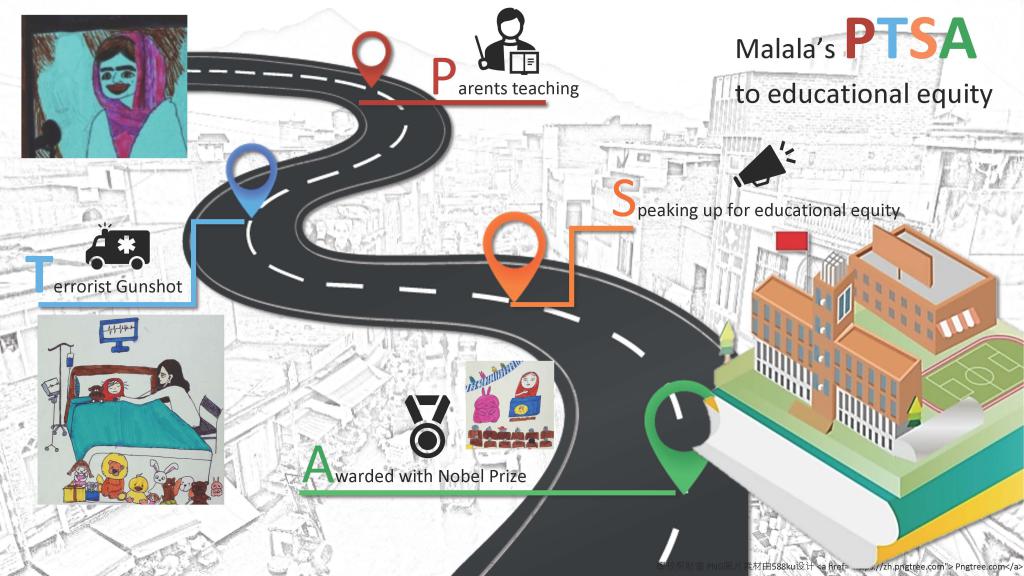 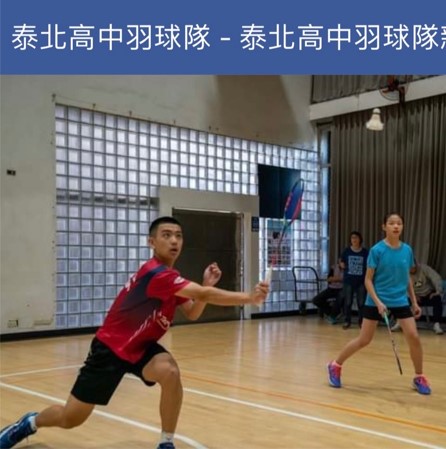 Malala簡報單元1 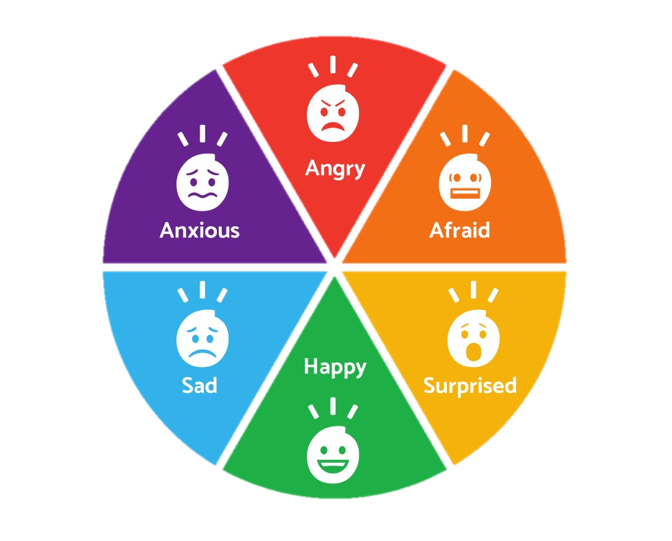 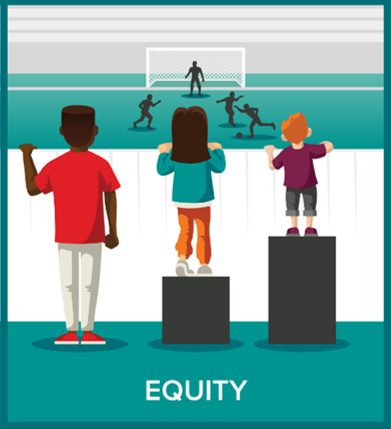 Malala 的故事 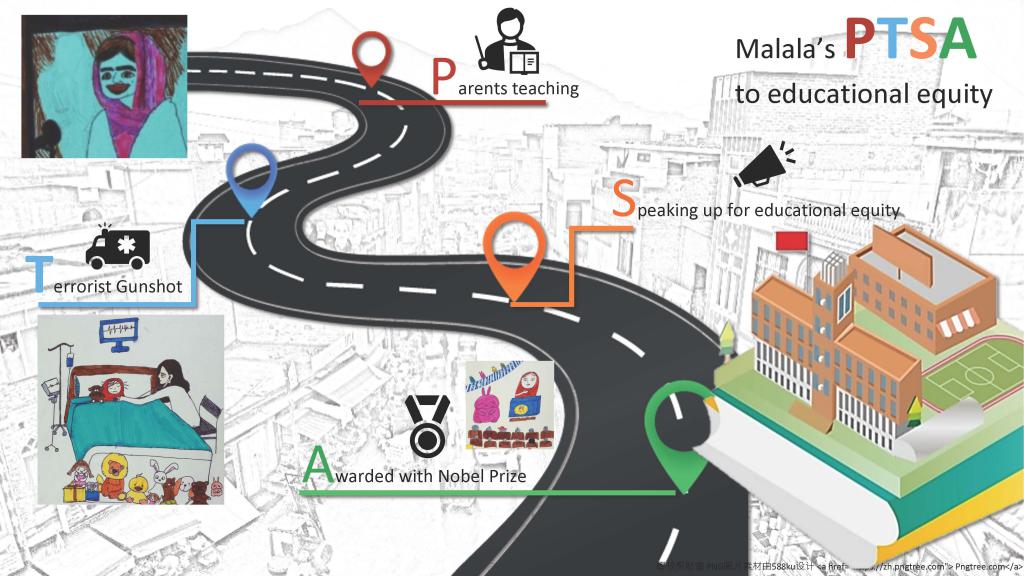 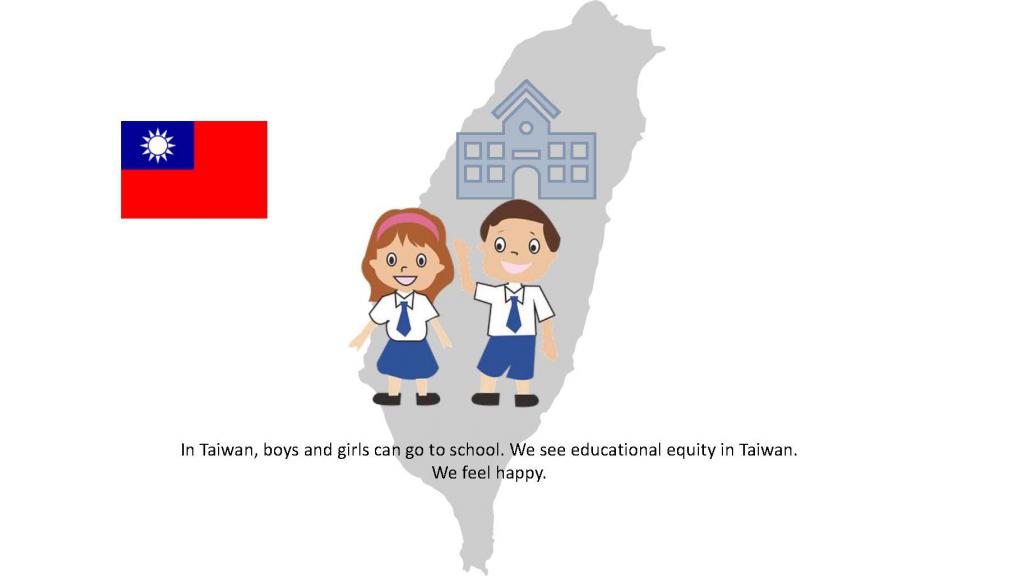 Malala簡報單元1 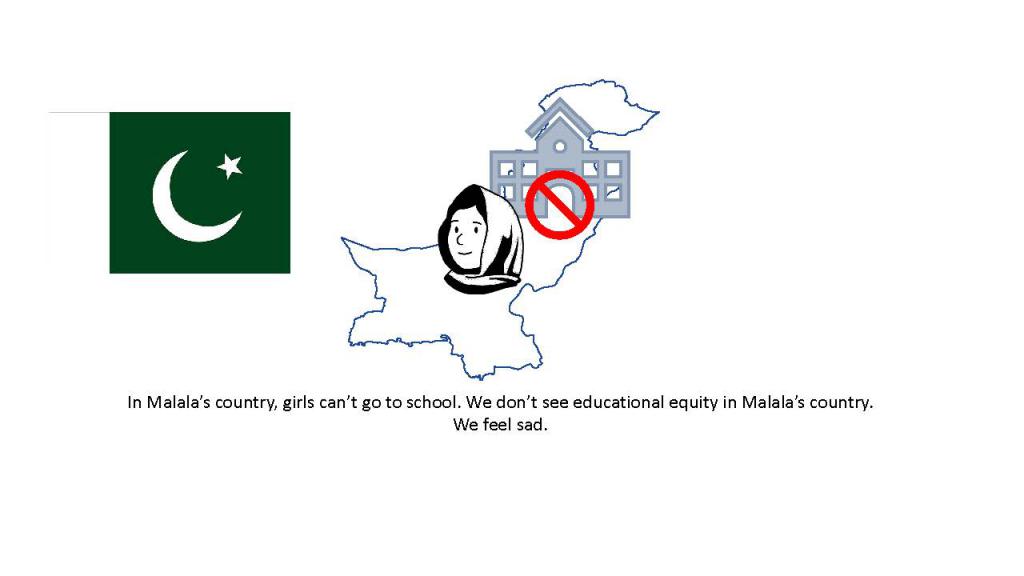 Malala簡報單元1  |
學生能回憶 我國及他國 2 性別學生上學權益的差異。
學生回憶 educational equity 的涵 義。 學生能反思educational equity的重要性。 學生能理解 Malala 倡 議、行動的 內容。 學生能理解 Malala的訴求及訴求對於該社會的正面價值。 學生能理解 educational equity的正面價值與值得人追求的 原因。 學生能理解我國平權環境下,男女分工合作的良好實例; 以及對比他國不平權環 境下的可能困境。 學生理解他國教育平權倡議者提出倡議的可能原因。 學生能理解色彩與感受的對應。 學生能使用色彩與感受的連結,表達對我國教育平權的感受。 學生能回憶Malala國家的教育不平權現況。 學生能對他國教育不平權現況表達個人感受。 學生能使用色彩與感受的連結,表達對他國教育不平權的感受。 學生能回憶臺灣教育平權的現況。 學生能對臺灣教育平權現況表達感受。 學生能用色彩與感受的連結,表達對臺灣教育平權的感受。 學生能回憶Malala的國家是否有教育平權。 學生能提出對於Malala國教教育平權現況的感受。 學生能運用色彩與感受的連結,呈現對於Malala國家教育不平權的感受。 學生能回顧educational equity的正向價值,並思考自我對Malala訴求的教育平權支持或反對。 學生能提出個人對於教育平權的價值判斷,並對Malala訴期的教育平權公開提出支持或反對。 |
|
融入領域
上課節數:7節
年級:八年級
國際教育議題實質內涵
學生學習目標
總結性評量
Girl with A Powerful Voice-劇本共創及話劇搬演(7節)
|
單元(三)單元名稱:(Girl with A Powerful Voice-劇本共創及話劇搬演)
|
|||
| 教學節次 |
第( 11 )節~第( 17 )節
|
||
| 國際教育議題實質內涵 |
國J11 尊重與維護不同文化群體的人權與尊嚴。
國J12 探索全球議題,並構思永續發展的在地行動方案。 |
||
| 相關領域學習表現 (第二學習階段以上應包含英語文領域領綱) |
[領域一]
1-Ⅳ-9 能辨識句子語調所表達的情緒和態度。 2-Ⅳ-9 能進行簡易的角色扮演。 2-Ⅳ-11 能參與簡易的英語短劇表演。 3-Ⅳ-13 能了解短劇的主要內容與情節。 6-Ⅳ-3 樂於參與有助提升英語能力的活動(如英語營、歌唱、朗讀、演講、段落寫作、讀者劇場等活動)。 7-Ⅳ-3 利用語言及非語言溝通策略(如請求重述、手勢、表情等)提升溝通效能。 8-Ⅳ-4 能了解、尊重不同之文化習俗。 [領域二] 表演藝術領域 表1-Ⅳ-1 能運用特定元素、形式、技巧與肢體語彙表現想法,發展多元能力,並在劇場中呈現。 表 3-Ⅳ-1 能運用劇場相關技術,有計畫地排練與展演。 |
||
|
校訂國際教育
雙語學習內容
|
領域學習內容 Content
|
||
|
國際上教育平權倡議者的故事
支持教育平權的戲劇表演方式 支持教育平權的戲劇劇本設計 |
|||
|
語言學習內容 Language of Learning
|
|||
|
目標字詞:
Terrorist, equity 目標句型: _____ don’t let girls go to school. I have the right to _____. I think Malala is _____. |
|||
|
單元學習目標
(50~100字內) |
運用英語文戲劇學生能理解馬拉拉的故事劇本內容,能以表演藝術方式表達對教育、平權的主張。
透過表演藝術戲劇演出,學生能理解教育平權的意義及價值及理解我國教育平權的與他國的差異。 |
||
| 教學步驟 | 引導作法 | 教學資源 | 認知能力 |
|
~~~~~第十一節~~~~
一、暖身活動
教師複習單元二透過繪本共創,理解我國與他國間,男女生上學情境的差異。
接著詢問學生 Teacher may ask: When your alarm goes off and wakes you up, what is your first thought ? Student may answer: 1. I just want to sleep. 2. I don’t want to go to school. 3. Why am I awake? Teacher may ask: In Malala’s country, can girls go to school? Students may say: Only boys can go to school. Teacher may ask: So, do think that we are lucky to go to school? Students may say: Yes. 二、教師引導學生閱讀繪本“For the right to learn”Malala Yousafzai’s story後,根據馬拉拉的故事先寫narrator介紹馬拉拉的出生地,介紹塔利班組織,馬拉拉父親的職業,與父親的對話,馬拉拉的演講引來塔利班槍殺,最後在英國恢復,最後獲得諾貝爾獎。
三、教師在引導學生共創劇本時,馬拉拉與父親的對白,馬拉拉說The Taliban cannot take away my right to education. I have the right to go to school.引導學生運用I have the right to的句型:
Teacher may say:
In Taiwan, we have educational equity. Boys have the right to go to school. Girls have the right to go to school. Do we have different “equity”? Like girls have the right to play basketball. Student may say: Girls have the right to ride scooter. Girls have the right to work. 四、教師藉此引導學生回憶教育平權之意義及價值,並帶出運用話劇方式幫助追求平權的動機。
Teacher may say:
Malala said: I have the right to go to school. Educational equity is good. In Taiwan, we have educational equity. Malala doesn’t have educational equity. 五、教師根據劇本人物角色,將全班分組,約 8 人一組。 各組學生依據劇本派定人物角色。
六、教師介紹 facial expression, eye contact, body language, emotion等戲劇演出之元素及其重要性。 七、教師帶讀劇本,在適當處停下,並詢問:
Teacher may ask:
You think Malala is _____? What would his/her facial expression/body movement be? Can you show us? 八、學生書寫 How can I perform better? 學習單,應用戲劇表演元素揣摩詮釋話劇中之人物角色,各組分享學習單書寫之內容,教師針對各組之分享給予回饋。
~~~~~~~~~第十一節課結束~~~~~~~~~
~~~~~~~~~第十二節至第十七節課~~~~~~~~~ 一、各組扮演相同角色之演員應用戲劇表演元素,同台較勁,彼此切磋,教師以英文指導,中文補充
二、師播放英語話劇排練相關影片,輔以中文字幕,各組速記話劇排練要點及注意事項並分享。
三、回家作業,教師指定各組研討下一劇本段落,下周演出該段落。
~~~~~~~~~第十七節課結束~~~~~~~~~
|
Malala簡報單元3 單元三學習單 |
理解Malala對倡議教育平權的行動與事件脈絡。 運用所學目標句型說明個人對平權的認知。 |
|
